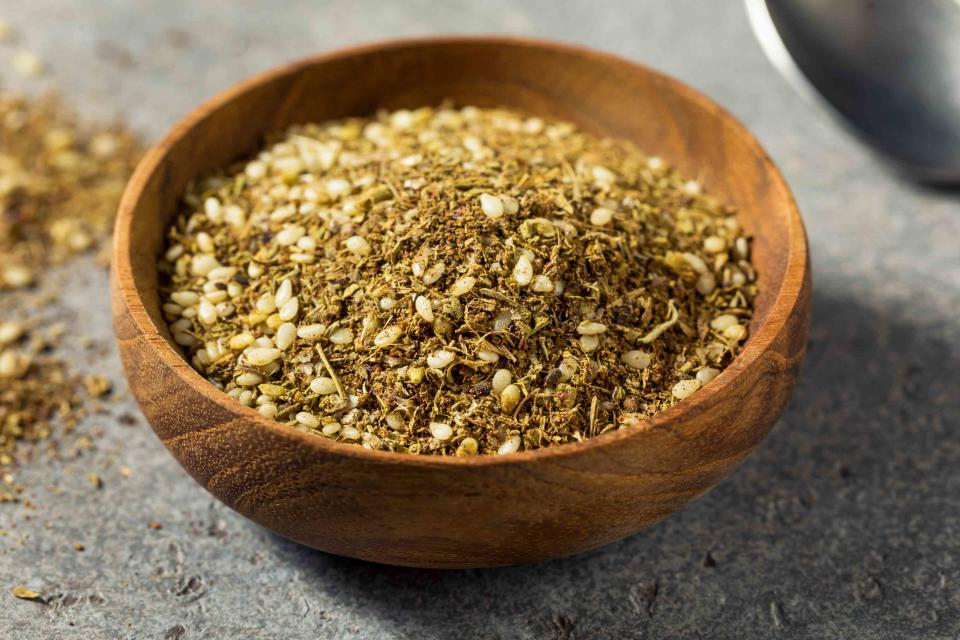A Guide to Za’atar, the Flavorful Middle Eastern Spice Blend
Use this powerhouse ingredient to add complex tangy, toasty, and herbaceous flavors to your cooking.

Getty Images
If your dish is missing a certain something, you may find what you’re looking for in za’atar. Popular across the Middle East, the complex spice blend offers layers of toasty, herbaceous, savory flavor, whether used as the rub for Za’atar Chicken or the seasoning for Za’atar Fire Crackers. Za’atar is available in stores, or you make it at home. Here’s everything you need to know about this pantry powerhouse.
What is za’atar?
Although the word za’atar is often used as shorthand for za’atar seasoning, it can also refer to za’atar itself, a wild herb with an oregano-like flavor. (Depending on where you are in the Middle East, it might also be called wild thyme, wild oregano, or hyssop.)
“A lot of za’atar isn’t even made with the actual za’atar plant, which grows wild all over the Levantine region,” says Zachary Engel, chef and owner of Galit in Chicago. “Instead a lot of domestic producers use thyme, oregano, marjoram, or any combination of the three.”
Alongside these herbs, za’atar typically includes sesame seeds and ground sumac, the latter of which offers a lemony tartness. Recipes for the blend can vary widely, but may also include salt, coriander, cumin, chili peppers, chili leaves, or citrus zest.
What does za’atar taste like?
“Since it’s not one singular spice, za’atar has a lot of balance in its overall flavor — vegetal, nutty, lemony, and zesty,” explains Engel. The flavor will vary depending on the blend you choose to source or make. Za’atar leaves, oregano, thyme, and/or marjoram add earthy, herbal, and floral notes, while sumac lends a tart lemony flavor, and the sesame seeds a toasty and nutty element.
How to use za’atar
Za’atar is incredibly versatile, adding its herbal complexity to dishes like Za’atar Spiced Beet Dip, Grilled Meatballs, and Za’atar Baked Eggs. In the Middle East, it’s often used as the topping for man’ouche, a za’atar flatbread, before it’s baked, or sprinkled over labneh with a drizzle of olive oil. You can use it as the rub for roasted proteins or vegetables, whip it into hummus, or stir it into olive oil for an easy dip.
“It’s great on roasted potatoes or other veggies as a side to a main course,” says Engel, who also suggests using it to season chicken or eggs. “It’s also really delicious on summer fruits like melon or peaches, sort of like a Middle Eastern Tajín.”
Where to buy za’atar
Za’atar can be found in the international aisle of many grocery stores or at most Middle Eastern markets, and is also widely available online. Engel is a fan of Ziyad Brothers za’atar, which can be purchased locally in Chicago and nationwide on Amazon. Other great sources include Burlap & Barrel, Kalustyan’s, New York Shuk, or Spicewalla. Look for a vibrant green color and fragrant smell when shopping for za’atar to ensure the dried herbs are fresh.
How to make za’atar seasoning
While there are plenty of excellent za’atar brands you can source online, making your own is a more cost-effective (and fun!) option. For his Za’atar Seasoning, chef and La Boîte spice shop owner Lior Lev Sezarc grinds za’atar leaves with sumac and a touch of salt in a spice grinder before stirring in lightly toasted unhulled sesame seeds. (He offers the alternative of marjoram, oregano, and thyme if you can’t source za’atar leaves.)
Engel also notes that you can easily experiment with different ratios of each ingredient to find the combination you prefer. He suggests using unhulled sesame seeds, which include the edible husk and offer a slightly bitter flavor, as they’ll keep for much longer than hulled ones. If you’re unable to source them, however, you can use regular sesame seeds for a za’atar that will still be delicious.
If making homemade za’atar, you can store it in a glass jar or spice jar with an airtight lid at room temperature for up to one month.
For more Food & Wine news, make sure to sign up for our newsletter!
Read the original article on Food & Wine.

